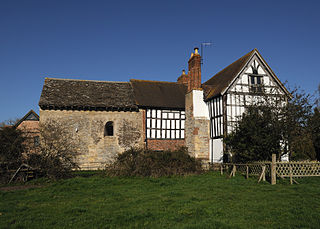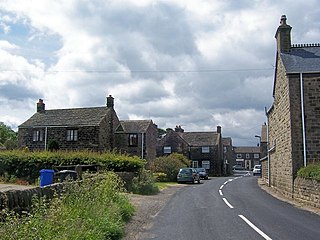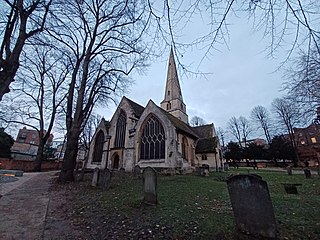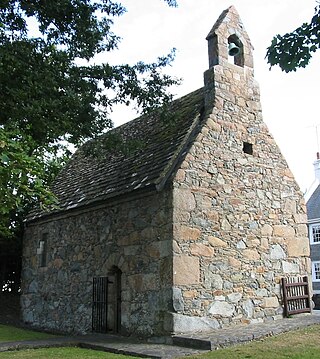
The Church of Our Lady and Saint Nicholas is the Anglican parish church of Liverpool. The site is said to have been a place of worship since at least the 1250s. The church is situated close to the River Mersey near the Pier Head. The Chapel of St Nicholas was built on the site of St Mary del Quay, which in 1355 was determined to be too small for the growing borough of Liverpool. It is recorded in the National Heritage List for England as a designated Grade II listed building, and is an active parish church in the diocese of Liverpool, the archdeaconry of Liverpool and the deanery of Liverpool North. It is part of the Greater Churches Group. From 1813 to 1868 the church was the tallest building in Liverpool at 174 feet [53 m], but then surpassed by the Welsh Presbyterian Church in Toxteth.

Odda's Chapel is a former chantry chapel at Deerhurst, Gloucestershire. It is an 11th-century late Anglo-Saxon building, completed a decade before the Norman Conquest of England.

Bolsterstone is a village in South Yorkshire, England, south of Stocksbridge, and 8.5 miles to the northwest of the City of Sheffield and within the city borough. It lies on the border of the Peak District national park. Bolsterstone had a population of 386 in 2011.

The Church of St. Nicholas, Bradfield is situated in the small village of High Bradfield, which is located 6 miles (10 km) north west of the centre of the city of Sheffield in South Yorkshire, England. It is one of only five Grade One Listed buildings in Sheffield. The church is situated 260 metres (850 ft) above sea level, overlooking the Peak District National Park.

St Peter's Church is the parish church of Prestbury, Cheshire, England. It is probably the fourth church on the site. The third, the Norman Chapel, stands in the churchyard. The church is recorded in the National Heritage List for England as a designated Grade I listed building. The Norman Chapel, the lychgate and west wall, the Hearse House, and the sundial in the churchyard are listed at Grade II. It is a Church of England parish church in the diocese of Chester, the archdeaconry of Macclesfield, and the deanery of Macclesfield.

Cheltenham Minster is the minster and parish church of Cheltenham in Gloucestershire, England.

St Nicolas Church is the Church of England parish church of Newbury, Berkshire, and stands just south of the main bridge over the River Kennet, in the centre of the town. The Grade I listed building is chiefly remarkable for the consistency of its Perpendicular Gothic architectural style and its unusually large size for a parish church.

The Church of St Mary, Ecclesfield, is situated on Church Street in the village of Ecclesfield, Sheffield, South Yorkshire, England. It is situated 4 miles (6.4 km) north of the city centre. It is a Grade I listed building, one of only five within the Sheffield city boundary. It was originally the parish church for Hallamshire, one of the largest parishes in England and in the seventeenth century was known as the "Minster of the Moors" due to its then rural situation.

St John the Baptist's Church is an Anglican church in Crawley, West Sussex, England. It is the parish church of Crawley, and is the oldest building in the town centre, dating from the 1250—although many alterations have been made since, and only one wall remains of the ancient building. In September 2017, a team from St Peter's Brighton began a new phase in the life of St John's Crawley. St John's offer a variety of services, traditional and informal, and contemporary services.

The Chantry Chapel of St Mary the Virgin is a chantry chapel in Wakefield, West Yorkshire, England, and is designated a Grade I Listed building by English Heritage. It is located south of the city centre on the medieval Chantry Bridge over the River Calder. It is the only survivor of four chantries in Wakefield and the oldest and most ornate of the surviving bridge chapels in England. Others are at St Ives (Cambridgeshire), Rotherham, Derby and Bradford-on-Avon. The chapel has had three west fronts, the original medieval façade having been removed to Kettlethorpe Hall in 1832. The medieval bridge is a scheduled ancient monument.

The Parish Church of St Peter, Great Berkhamsted, is a Church of England, Grade II* listed church in the town of Berkhamsted, Hertfordshire, in the United Kingdom. It stands on the main High Street of the town and is recognisable by its 85-foot (26 m) clock tower.

The Church of St Mary the Virgin, Aldermaston, is the Church of England parish church of Aldermaston in Berkshire. The church, which is dedicated to St Mary, dates from the mid-12th century and has examples of Norman and Jacobean architecture. The building has had a number of extensions, particularly in the 13th, 14th, 15th and 17th centuries.

Christ Church is an Anglican church in the town and seaside resort of St Leonards-on-Sea, part of the Borough of Hastings in East Sussex, England. Opened as the town's third Anglican church in 1860 to serve a rapidly developing residential area and to accommodate poor worshippers who could not afford pew rents at the fashionable St Leonard's and St Mary Magdalene's Churches, the original building was superseded by a much larger church built next to it between 1873 and 1875. Prolific ecclesiastical architect Sir Arthur Blomfield's simple Gothic Revival design forms a landmark on one of St Leonards-on-Sea's main roads, continues to serve a large area of the town and maintains a strong Anglo-Catholic tradition. It has been described as Blomfield's "finest achievement in Sussex" and "one of the main centres of Anglo-Catholic worship in Southern England". The interior fittings are the best of any church in the borough, and the design has been called one of Blomfield's most successful. St John the Evangelist's Church, founded as a daughter church nearby in 1865, also continues to thrive as a separate parish church. Historic England has listed Christ Church at Grade II* for its architectural and historical importance.

The Church of St Nicholas, Charlwood, is the parish church of Charlwood, Surrey, England. With a 12th-century tower and nave section and examples of 13th to 15th century art, fixtures and architecture, it is a Grade I listed building.

St Mary's Church is the main Church of England parish church for the areas of Portsea and Fratton, both located in the city of Portsmouth, Hampshire. Standing on the oldest church site on Portsea Island, the present building, amongst the largest parish churches in the country, has been described as the "finest Victorian building in Hampshire". It is at least the third church on the site and has been designated a Grade II* listed building by Historic England. Former regular worshippers here have included Charles Dickens, Isambard Kingdom Brunel, and Cosmo Lang.

St Andrew's Church is an Anglican parish church in the centre of Farnham, Surrey. It is a Grade I listed building and surviving parts of the structure date back to the Middle Ages. It is in the Archdeaconry of Surrey, in the Diocese of Guildford. The churchyard contains the grave of the political activist William Cobbett, and there is a memorial to the hymn-writer Augustus Toplady.

The Church of St Mary of the Assumption is in Yorkshire Street, Burnley, Lancashire, England. It is an active Roman Catholic parish church in the diocese of Salford. The church is recorded in the National Heritage List for England as a designated Grade II listed building. It was built between 1846 and 1849 to replace a smaller chapel on a different site. The church was designed by Weightman and Hadfield in Decorated style, and a chapel was added to it in 1879.

St Peter's Church is the Church in Wales parish church for the town of Carmarthen, Wales. Though founded much earlier, the present building dates from at least the 14th century. It is the largest church in the Diocese of St David's and is a Grade I listed building. It is also the oldest surviving building in Carmarthen.

The Chapel of St Apolline, La Grande Rue, Saint Saviour, Guernsey is a protected building and historic monument. Constructed in the 14th century, it is still in regular use for worship. The Chapel has stood virtually unchanged for over 600 years.

St Winnow's Church, St Winnow is a Grade I listed parish church in the Church of England in St Winnow, Cornwall.























